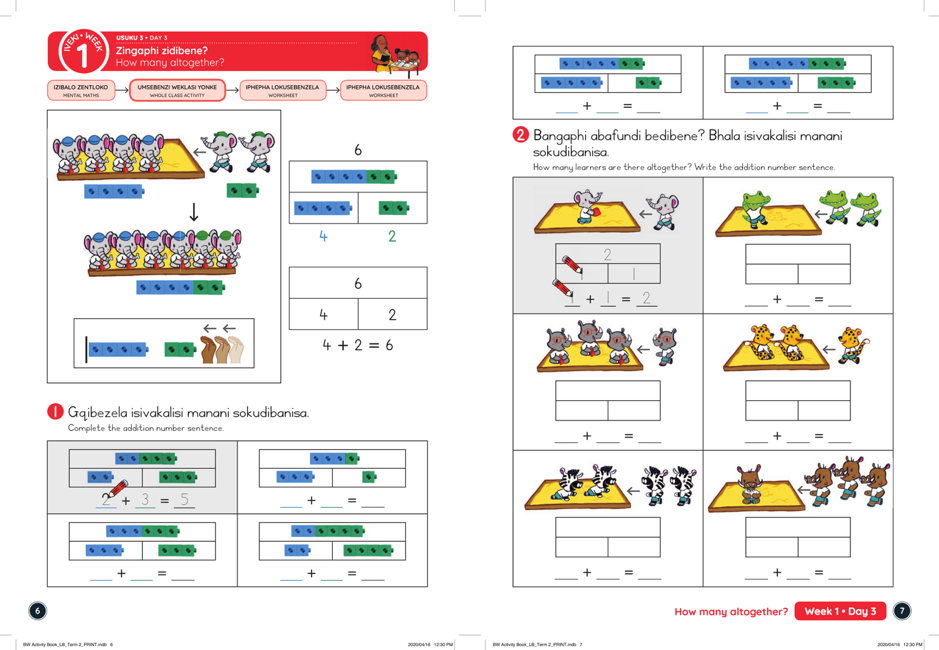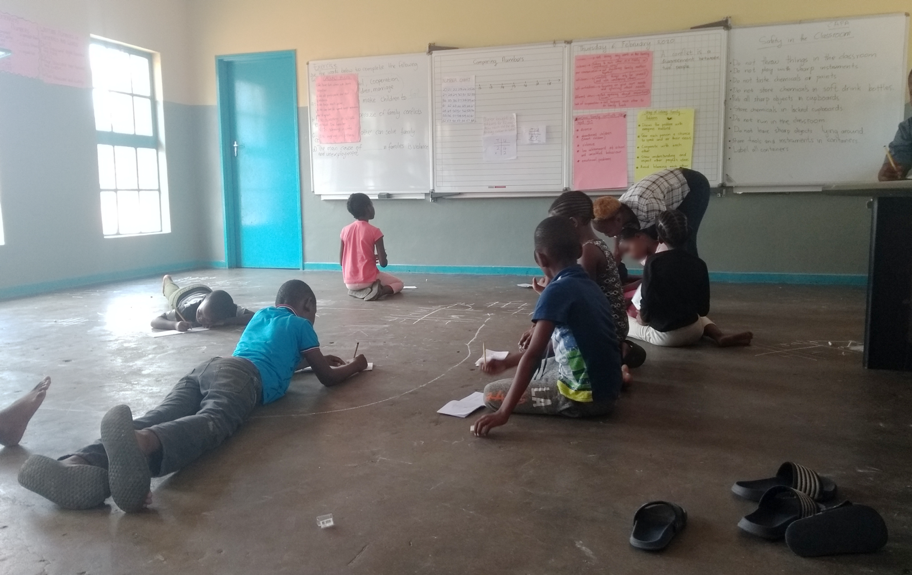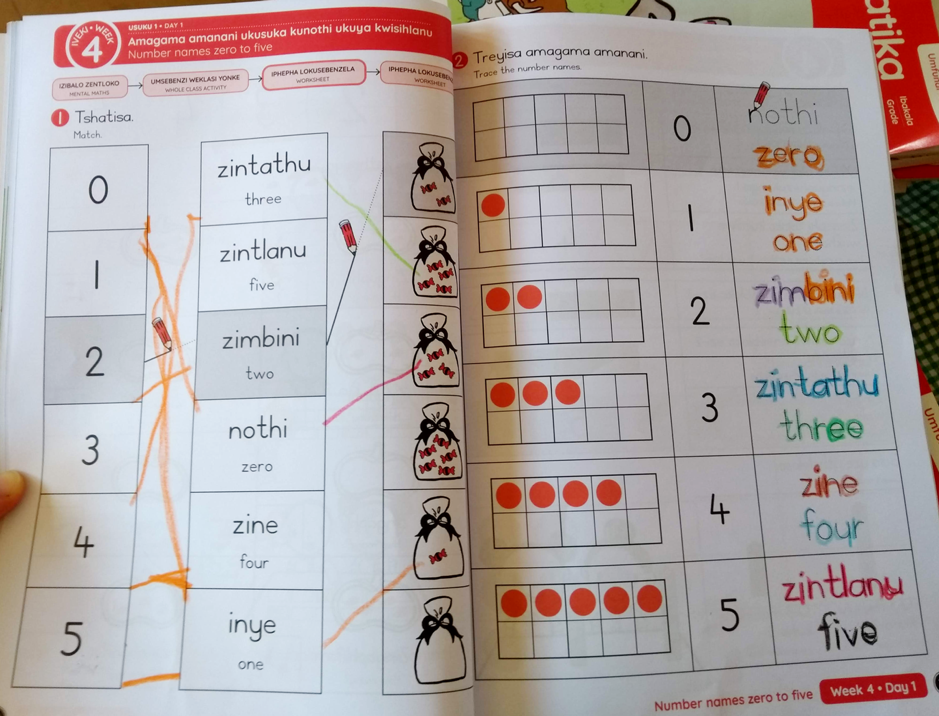Yue-Yi Hwa
Blavatnik School of Government, University of Oxford
Blog
Earlier this year, in pre-lockdown days, my RISE colleague Michelle Kaffenberger and I visited educational NGOs Funda Wande in South Africa and Young 1ove in Botswana. These site visits taught us a lot about these NGOs’ strategies for influencing education at the system level.
The visits also helped us to reflect on the role of instructional materials in improving learning. By instructional materials, we mean the materials that support classroom lessons—whether textbooks, workbooks, worksheets, lesson plans, activity guides, posters, or hands-on manipulatives.
In well-resourced education systems, teachers and students can usually take for granted a wide selection of high-quality instructional materials. This may not true in low-resourced systems. For example, in a recent study of remote school districts in Indonesia, only 39% of surveyed schools reported having enough textbooks.
To remedy local shortcomings in the supply of instructional materials, South African not-for-profit Funda Wande, directed by RISE fellow and University of Stellenbosch RESEP research fellow Nic Spaull, has borrowed a strategy from public health. Here is Spaull’s view, from a blog about their new mathematics programme, Bala Wande:
The aim is to develop fully bilingual learner activity booklets and video-based teacher guides for Grade 1-3 in all South Africa’s official languages. The big aim is to delink price and quality, and offer “best in the world”, in African languages, openly-licensed and widely available. If the pharmaceutical industry can create ‘generic drugs’ (same quality but MUCH cheaper), we can do the same with early learning resources!”
Accordingly, all Funda Wande instructional materials—books, lesson plans, posters, and more—as well as their training videos are open-source and freely available online.

An example activity from the Bala Wande mathematics learner activity book for Grade 1, Term 2. To see a teacher introducing children to this activity, watch this training video.
Open licensing may be gaining traction as a way of addressing supply shortfalls of instructional materials in low- and middle-income countries. At the recent the virtual conference of the Comparative and International Education Society, one panel saw presentations on open licensing in countries spanning Cambodia, Guatemala, and Rwanda, among others.
t’s not just the quantity of instructional materials that matters, but also their quality. In order to facilitate learning gains, instructional materials must suit the particular challenges and circumstances facing their users, both students and teachers. For example, Glewwe, Kremer, and Moulin (2009) found that providing textbooks to Kenyan students only raised the test scores of higher-achieving children, partly because the textbooks were too difficult for most children’s skill levels, and partly because they were in English, which was most children’s third language. Given these mismatches, the standalone quality of the textbook content was immaterial, because textbooks were incoherent with the linguistic context and with students’ current learning levels.
More broadly, instructional materials for early-grade literacy must fit the linguistic and orthographic structure of the language in question, which may differ from that of English and the other European languages that predominate in pedagogical research on reading. Also, instructional materials should be calibrated to match and build on students’ prior knowledge, whether for learning languages or for other subjects.
Crafting instructional materials that meet real classroom needs is challenging—but worthwhile. High-quality and well-calibrated instructional materials can substantially improve both learning outcomes and teacher motivation. This was evident in Tongan schools under the Pacific Early Age Readiness and Learning (PEARL) programme, which involved “instructional materials for teachers and students, including a teacher guide, student workbooks and readers, and assessment tools for teachers to track student progress during the school year, all in Tongan language” (PEARL Operational Guide, p. 9). An RCT of PEARL found that the percentage of students able to read with comprehension by the end of grade 2 increased from 18% to 29%. Similar effects have been seen elsewhere, as in Kenya’s nationwide Tusome early-grade reading programme.

Children in a Young 1ove TaRL lesson in Gaborone, Botswana, working on the day’s checkpoint question, supported by their facilitator (in the black-and-white blouse). To create a relaxed atmosphere for the after-school TaRL sessions, classroom desks and chairs are pushed aside, and children are encouraged to change out of their school uniforms before the sessions begin.
In Botswana, Young 1ove’s implementation of Teaching at the Right Level (TaRL) numeracy caters not only to children’s preferences—using hands-on activities, dances, and games—but also to their learning needs. Young 1ove’s TaRL instructional materials are designed to support facilitators in tailoring each day’s lesson to the group’s learning level. At the end of each session, each child completes a checkpoint maths problem to test their mastery of the day’s content. If approximately 70% of children complete the problem correctly, the next day’s lesson will move on to the next topic. If fewer than 70% are correct, the topic is re-taught the next day. If all children answer the checkpoint correctly, this may indicate that the day’s material was too easy, and facilitators will adjust the rate of progress accordingly.
Evaluating the quality of instructional materials is a demanding process. Besides using developmentally and contextually appropriate pedagogy, instructional materials should be aligned to match curricular standards as well as the standards implicit in national exams (which is even less straightforward when curricula and exams are themselves misaligned).
This goes beyond individual subjects: an internally coherent grade 1 numeracy exercise that matches the progression of the mathematics curriculum may nevertheless trigger confusion if it assumes a level of literacy that the grade 1 language curriculum has yet to reach. Given all of these considerations—to say nothing of the numerous other demands on frontline providers’ time—it can be difficult for school heads and teachers to judge whether or not to invest time, thought, and money into a particular set of instructional materials.

This image is from a grade 1 maths lesson that we observed with Funda Wande in Port Elizabeth, South Africa. The page on the left shows a mathematics exercise that was carefully aligned with children’s emerging numeracy skills, but too difficult for their emerging literacy skills. During this lesson, both the teacher and the Funda Wande staff who were observing the lesson immediately pinpointed the mismatch. The Funda Wande team plan to fix this mismatch in subsequent versions of the Bala Wande mathematics learner activity book for Grade 1, Term 1.
Unfortunately, this burden of evaluating instructional materials often falls disproportionately on frontline providers, especially in under-resourced education systems that may lack quality-promotion mechanisms such as government-led textbook approval criteria or a critical mass of trusted and trustworthy educational publishers.
This is not to suggest that teachers shouldn’t have the freedom to modify existing materials, create their own materials, or judge which materials are best for their classrooms. But they shouldn’t have to do this in a vacuum. Novice chefs learn to cook by following tried-and-tested recipes; while experiences chefs can tweak old recipes or draw on their stock of knowledge to create new ones. Similarly, teachers should be given access to a range of high-quality pedagogical resources. They should not have to design new materials for every lesson from scratch.
All of these factors matter: adequate supply, contextual suitability, pedagogical quality, and coherence with other aspects of learning. When I was teaching English at a high-need secondary school in Malaysia, local bookshops offered shelf upon shelf of commercially published workbooks. To cut costs, many teachers would buy a single workbook and distribute photocopied pages to their students, rather than buying a full set of workbooks for the class.
I had a different problem: both the workbooks and the government-issued textbook were geared toward the secondary school exit exam—which, for English, expected students to write 350-word essays. But most of the students in my classrooms struggled to write a single grammatically correct sentence. The internet offered an abundance of English lesson materials, but quality was highly variable. Also, the materials that matched my students’ learning levels typically used reading texts that were far too juvenile to engage restless 16- and 17-year-olds. I spent hours writing simple passages based on movie plots and current events, and then developing comprehension questions that matched the format of the exit exam, even if they fell far short of its difficulty level. But on some days, I simply didn’t have the time and energy for that. Frankly, my students deserved better. And so do their peers everywhere.
Note: Here are links to what Funda Wande and Young 1ove have been doing to support students and teachers during the Covid-19 pandemic.
RISE blog posts and podcasts reflect the views of the authors and do not necessarily represent the views of the organisation or our funders.